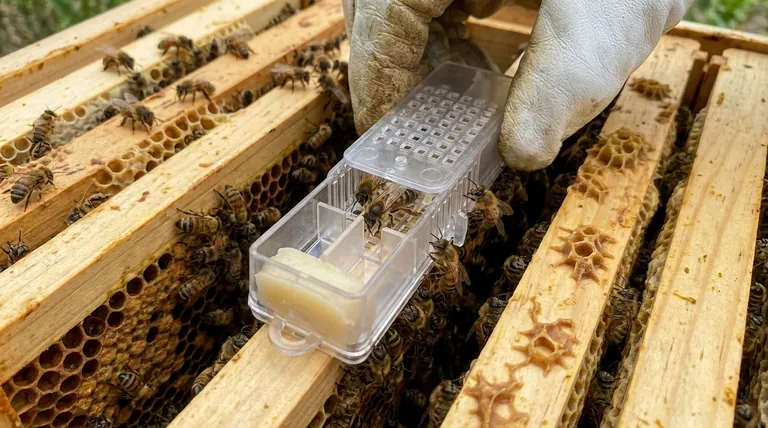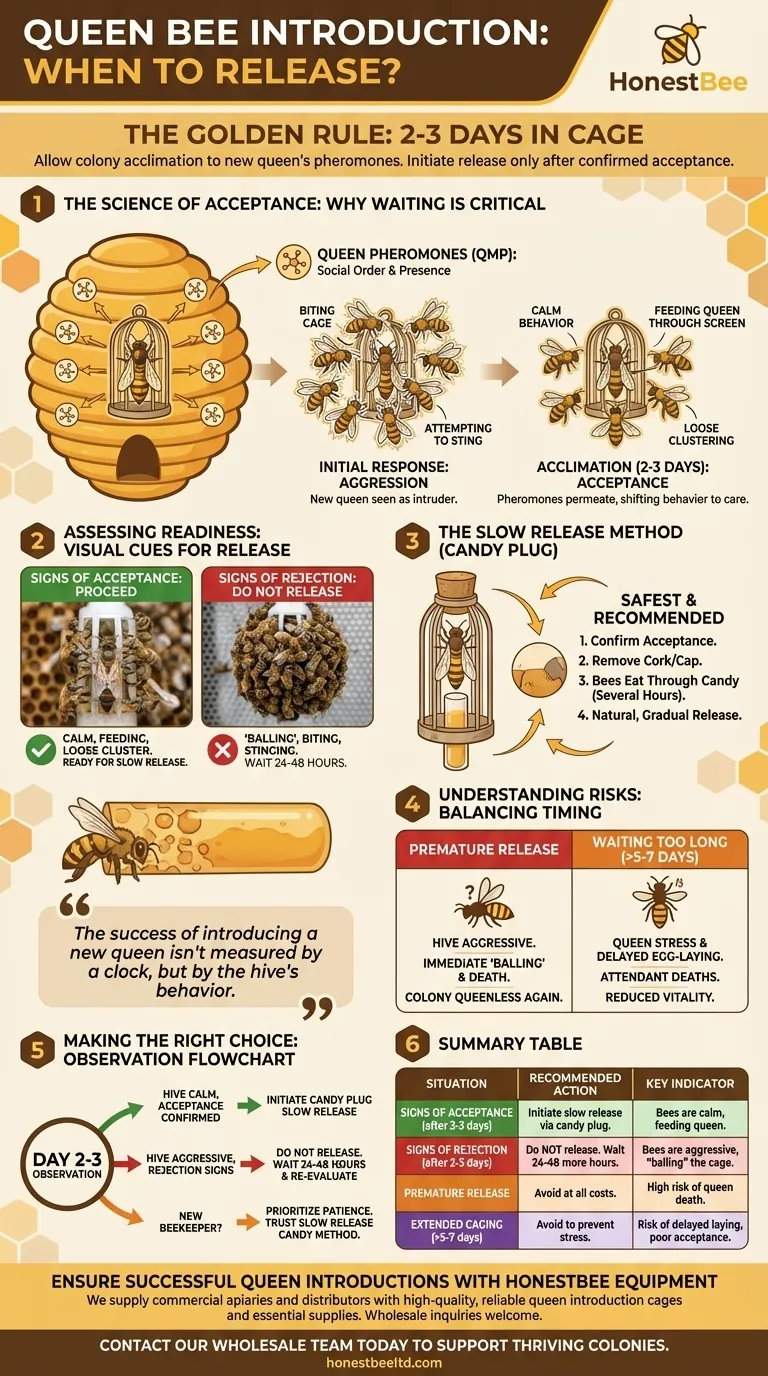As a general rule, a new queen bee should remain in her introduction cage inside the hive for 2 to 3 days. This period allows the colony's worker bees to acclimate to her unique pheromones. After this adjustment period, you can enable her release, ideally allowing the bees to free her themselves by chewing through a candy plug.
The success of introducing a new queen isn't measured by a clock, but by the hive's behavior. The 2-3 day guideline is a starting point, but the true signal for release is the colony's transition from aggression to acceptance.

The Science of Acceptance: Why Waiting is Critical
Introducing a new queen is one of the most delicate operations in beekeeping. The hive is a complex society governed by scent, and the queen's specific pheromone signature is the chemical that holds it all together.
The Role of Queen Pheromones
Every queen produces a unique blend of chemicals, most notably the Queen Mandibular Pheromone (QMP). This scent signals her presence, suppresses worker bee reproduction, and maintains social order. A new queen is essentially an intruder with a foreign scent.
From Aggression to Care
Initially, worker bees will recognize the new queen as a threat. They may exhibit aggressive behavior like biting the cage or attempting to sting her through the mesh. The caging period gives the workers time to adjust. As her pheromones permeate the hive, their behavior will shift to curiosity and eventually acceptance, where they will begin to feed and groom her through the cage.
Assessing the Hive's Readiness for Release
While 2-3 days is a reliable benchmark, you must verify the hive's attitude before proceeding. A visual inspection of the queen cage tells you everything you need to know.
Signs of Acceptance
Look for calm behavior around the cage. The worker bees will be gently walking on the cage, attempting to feed the queen through the screen, and clustering loosely. This indicates they have accepted her scent and are ready to welcome her as their new leader.
Signs of Rejection
If the bees are still acting aggressively after 2-3 days, do not release the queen. Signs of rejection include "balling," where bees form a tight, angry cluster on the cage, biting at the mesh and trying to sting the queen. If you see this, leave the queen caged and check again in another 24-48 hours.
The Slow Release Method (Candy Plug)
Most queen cages come with a small tube blocked by a sugar candy plug. After confirming acceptance, you simply remove the cork or cap from the candy end. The worker bees will then eat through the candy over several hours, giving the queen a gradual and natural release into the colony. This is the safest and most recommended method.
Understanding the Trade-offs and Pitfalls
Rushing or delaying the queen's release both carry significant risks that can determine the fate of your colony.
The Risk of Premature Release
Releasing a queen into a hive that has not yet accepted her is almost always a death sentence. The workers will immediately "ball" and kill her, perceiving her as a foreign invader. This sets your colony back significantly, leaving it queenless once again.
The Danger of Waiting Too Long
Leaving a queen caged for an extended period (more than 5-7 days) can also be detrimental. She may become stressed, her egg-laying can be delayed, and the attendant bees with her in the cage may die. This added stress can reduce her vitality and pheromone output, ironically making acceptance harder.
Making the Right Choice for Your Hive
Your decision on when to initiate the release should be based on observation, not just the calendar.
- If your hive is calm and you've confirmed acceptance after 2 days: You can confidently remove the cork to expose the candy plug and allow the slow-release process to begin.
- If your hive is still showing signs of aggression on day 3: Do not release the queen. Give the colony another 24-48 hours to acclimate and re-evaluate their behavior before proceeding.
- If you are a new beekeeper: Always trust the slow-release candy plug method and prioritize observing signs of acceptance over adhering to a strict timeline.
Patience is the beekeeper's greatest tool in ensuring the colony successfully embraces its new queen.
Summary Table:
| Situation | Recommended Action | Key Indicator |
|---|---|---|
| Signs of Acceptance (after 2-3 days) | Initiate slow release via candy plug. | Bees are calm, feeding the queen through the cage. |
| Signs of Rejection (after 2-3 days) | Do NOT release. Wait 24-48 more hours. | Bees are aggressive, 'balling' the cage. |
| Premature Release | Avoid at all costs. | High risk of the queen being killed. |
| Extended Caging (>5-7 days) | Avoid to prevent queen stress. | Risk of delayed egg-laying and poor acceptance. |
Ensure your queen introductions are successful with the right equipment from HONESTBEE.
We supply commercial apiaries and beekeeping equipment distributors with high-quality, reliable queen introduction cages and other essential beekeeping supplies through our wholesale-focused operations. Proper equipment is fundamental to managing hive health and productivity.
Contact our wholesale team today to discuss your apiary's needs and discover how our products support thriving colonies.
Visual Guide

Related Products
- Professional Multi-Functional Queen Bee Cage
- Durable Galvanized Steel Spring Queen Bee Cage
- Multi-Function Queen Roller Cage and Catcher
- Professional Multi-Compartment Queen Cage with Sliding Lid
- Wood and Mesh Push-In Queen Cage
People Also Ask
- What should be done if bees damage the queen cage or harm the queen? Rescue Your Queen and Save Your Hive
- What items are needed to place the queen bee's cage in the hive? A Guide to Successful Queen Introduction
- How should a queen cage be maintained over time? Ensure Queen Introduction Success
- What is sequestration, and how does it help bees reorient? A Safer Guide to Hive Relocation
- What are common mistakes to avoid when using queen cages? Ensure Successful Queen Introduction



















